Scientific Background, Problem Identification and Objective of the Proposed Research
The 50th anniversary of the worldwide student and workers movement of 1968, with its impact on Slovenia and other republics of the Socialist Federal Republic of Yugoslavia, gives this research project the opportunity to address, from the viewpoint of world-systems analysis, the open questions that this “antisystemic movement” (Arrighi, Hopkins & Wallerstein, Antisystemic Movements, Verso 1989) poses to contemporary research on world literature, modernism, and the international social movements of the 20th and 21st centuries:
- Even though the worldwide student and workers movement of the 1960s was retroactively reduced to a cultural phenomenon (as shown by Ross, May ’68 and Its Afterlives, U of Chicago P 2002), the role of literature and theory in these processes remains underresearched. By comparing the core (Paris) with the periphery (Ljubljana, Zagreb, Belgrade) of the literary world-system, the project will try to assess whether the radicalism of 1960s modernist literature and critical theory offered a starting point to the student and workers movement, rather than a mere reflection on (or even a passive witnessing of) the movement. What was the relation between critical theory and the student movement in the European part of the core and in the peripheries, in this “age of theory” (Adorno)? Were Sartre and Marcuse really the only theorists whose status of ideologues of the movement could be compared to that of Rubin, Dutschke, Cohn-Bendit, and other activist leaders? Was there perhaps a distance between the movement and theory? Finally, are the subsequent renunciations of both May ’68 and French (post)structuralism proof that the social revolt and theory were overdetermined by a common structure?
- As shown by Combes (Mai 68, les écrivains, la littérature, L’Harmattan 2008), French modernist and neo-avant-garde experiments (e.g., Tel Quel, Internationale situationniste) and French theoretical critique of literature as a bourgeois institution formed the basis of the French student movement. Additionally, many students were inspired by the Chinese Cultural Revolution—whose origins are themselves symptomatically connected to a critique of the literary. The project will investigate whether the neo-avant-garde transgression of literariness and the theoretical critique of the literary had a similar impact in the periphery as well, where there was a different social and economic formation. Are the analogies between the French and the Slovenian case when it comes to the interaction of theory and literature perhaps the result of their common social function in both societies, namely their shared utopia of a total transformation of the existing order, a utopia spanning from sexuality to the mode of production to international relations and to aesthetics?
- By comparing the Parisian core with the Slovenian and Yugoslav periphery, the project will test the hypothesis that the transnational student movement effectively functioned as a key medium of increasingly accelerated transfer of modernist and neo-avant-garde theoretical and literary practices from the core of the world-system to its periphery.
- In view of Perry Anderson’s thesis that an imaginative proximity of revolution is constitutive of modernism (“Modernity and Revolution,” New Left Review 1984, no. 144), could one not argue that the worldwide revolutionary movement of students fashioned a new kind of modernism that went beyond a worn-out formalism? Is in this regard the metropole of Paris really significantly different from the periphery of Slovenia and Yugoslavia?
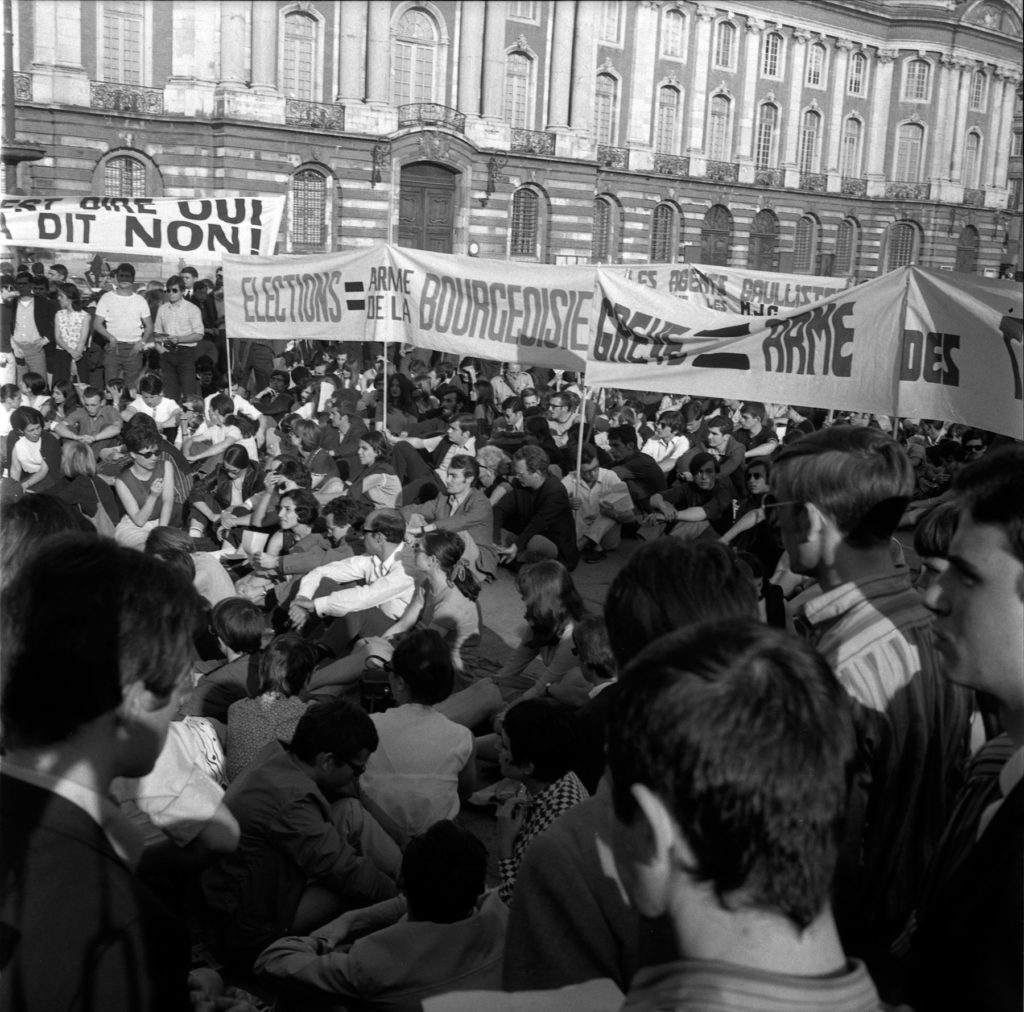
1 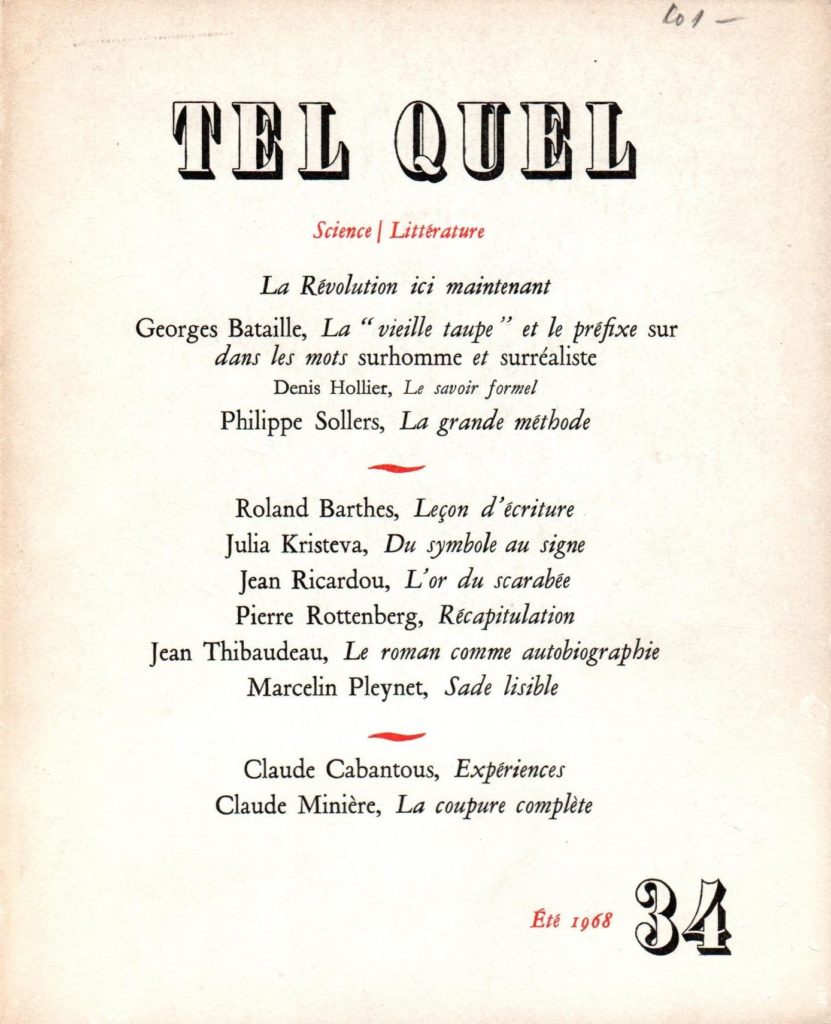
2 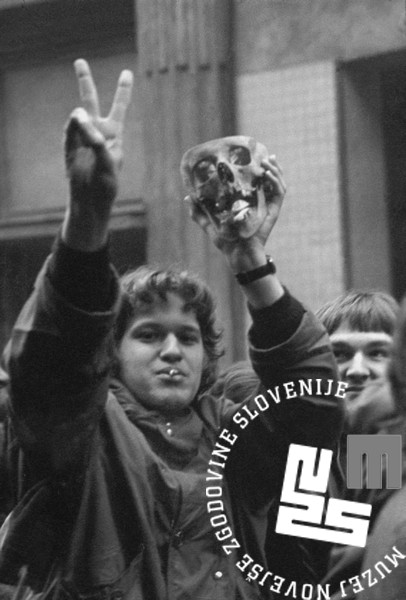
3
Picture 1: Student protest in Toulouse, June 1968 (source: Wikimedia commons).
Picture 2: Title page of Tel Quel, summer 1968: revolution, literature, and theory
Picture 3: Student protests – the occupation of the Faculty of arts, Ljubljana, May 1971 (photo: Edi Šelhaus, source: Muzej novejše zgodovine Slovenije)
To critically reflect on the historical distance to the last phase of modernism, the project will take into consideration both the dominant accounts of May ’68 and the recent alternative readings. To this end, the project will also analyze the conditions in which utopianism (both political and aesthetic) still seemed possible.
State-of-the-Art in the Proposed Field of Research and Survey of the Relevant Literature
According to Jameson (A Singular Modernity, Verso 2002) and Anderson (“Modernity and Revolution”), the modernism of the first decades of the 20th century is characterized by resistance to the commodification of culture and by an imaginative proximity of revolution. Nonetheless, after World War II the potential of this modernism itself is said to have been either commodified and canonized (core modernisms) or lost in belated repetition (peripheral modernisms).
The Eurocentric view that the origin and the measure of modernity reside solely in Western metropoles was recently countered by the conception of plural modernisms (e.g., Geomodernisms, ed. Doyle & Winkiel, Indiana UP 2005; Translocal Modernisms, ed. Santos & Ribeiro, Lang 2008; The Oxford Handbook of Global Modernisms, ed. Wollaeger & Eatough, Oxford UP 2012; Friedman, Planetary Modernisms, Columbia UP 2015). However, this conception itself masks the single ideological and economic background of the various modernisms, hollowing out the very notion of modernism in the process. Hence, the project will undertake a comprehensive comparative analysis of the literary texts related to May ’68 in an attempt to develop a world-systemic model of modernism. Following Jameson, it will test the hypothesis that the essence of modernism is to be found neither in the Western metropoles nor in the global periphery, but rather in the asymmetrical structure of relations between particular modernisms within the modern world-system.
As shown by Moretti (Distant Reading, Verso 2013), the periphery of the literary world-system is forced into a compromise between foreign, Western forms and local topics and viewpoints. Moretti further claims that modernism was “the last creative drive of European literature” (or, as he stated earlier in his Signs Taken for Wonders [Verso 1983], “the last literary season of Western culture”). In his view, modernism as the last season of innovative European literature was followed by the rise of postcolonial literatures as the new main provider of innovation in the literary world-system. As it was shown recently, May ’68, too, drew inspiration from and supported the anticolonial struggle. Hence, the proposed project will argue that the worldwide antisystemic movement of students (seeking an alliance with workers), too, succeeded in revitalizing modernism—which within the aesthetic field is essentially an antisystemic current. The project will scrutinize this claim in view of peripheral modernisms such as Slovenian modernism and neo-avant-gardes. It will propose and test the hypothesis that the last season of modernism in fact took place in a periphery, precisely as a kind of a singular compromise with foreign forms. Could it be that such a periphery revitalized global modernism by local neo-avant-garde practices and theory (e.g., the OHO group or Žižek)? The project will test the hypothesis that the last season of modernism is the period when a society like peripheral Slovenia, as part of socialist and non-aligned Yugoslavia, synchronized itself, via the worldwide student movement, with the core, thus realizing the inherent tendency of modernism.
Limited for this presentation on book-length studies, the state of the art in the research on May ’68 in relation to the focus of the project can be divided into three levels: a) the world, b) Yugoslavia, and c) Slovenia.
A) As is well known, May ’68 signifies a transformative political, social, and cultural movement on the global scale. The capitalist West and the socialist Second World both experienced the irruption of their unpredictable and apparently anarchic energies. As a major global event, May ’68 and the subsequent developments in the early seventies were relatively well documented and studied, beginning with the 10th anniversary of the May events. Opposing both the mythologization and revisionist denunciation of May ’68, many individual national histories have studied its documents; for example, Berglieb’ 1968: Literatur in der antiautorären Bewegung (Suhrkamp 1993) meticulously presents the sources of the revolt in West Germany as well as the role of literary intellectuals, critical theorists, and philosophers.
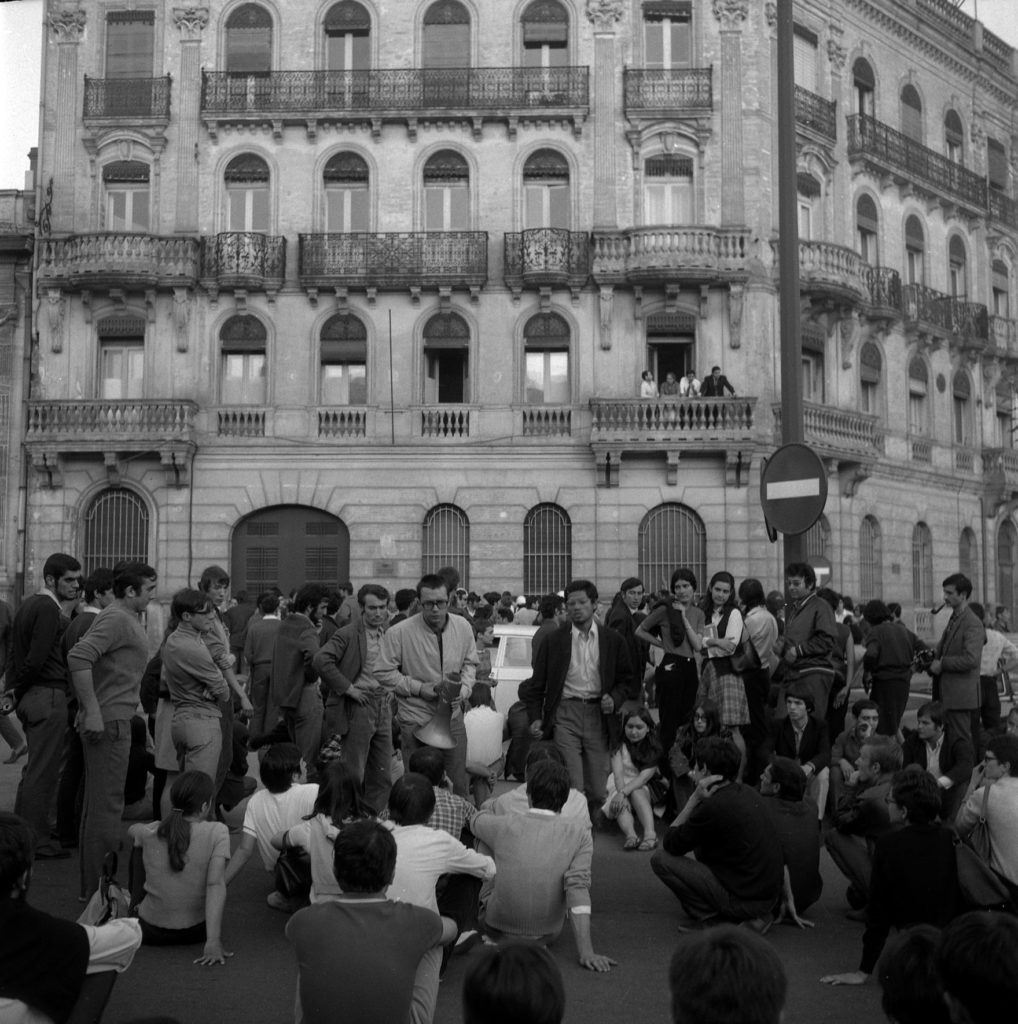
4 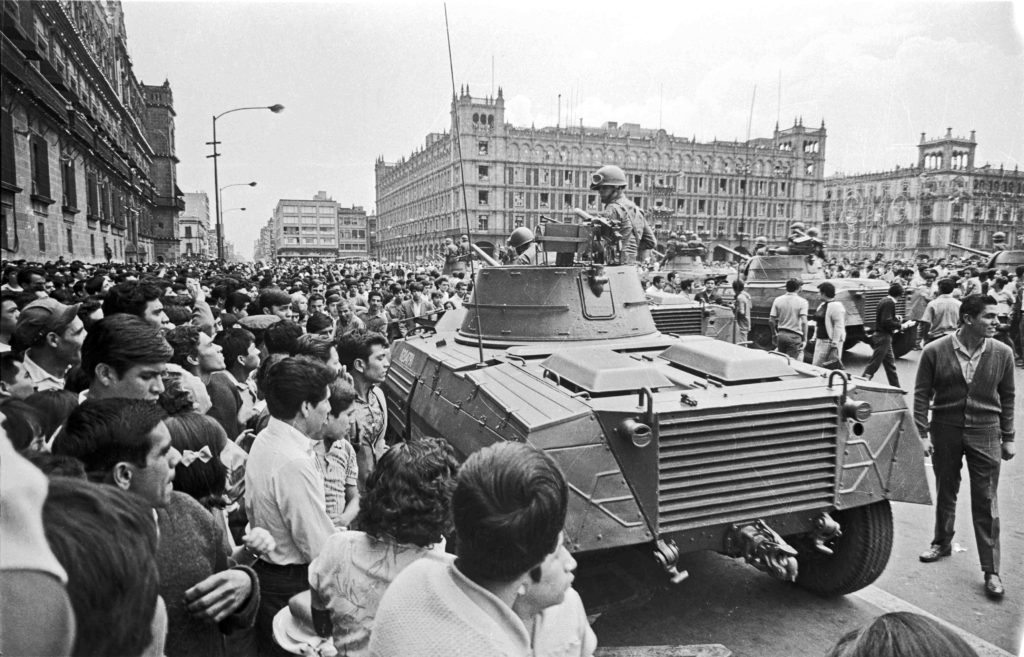
5 
6
Picture 4: Student protest in front of the national radio-television office (ORTF), Toulouse, June 1968 (source: Wikimedia commons)
Picture 5: Armored vehicles in Mexico City, 1968 (source: Wikimedia commons)
Picture 6: Anti-Vietnam protest in West Berlin, 1968 (source: Wikimedia commons)
However, the existing writing on May ’68 largely concentrates on Paris and France, especially on the relationships between the student movement, the university, and counterculture. Within the discussions of the events in France, a valuable change of focus has been proposed by Combes. In his Mai 68, les écrivains, la littérature (L’Harmattan 2008), Combes carefully reconstructs how controversies in and about literature shaped the intellectual climate of May ’68. The project will draw on Combes’ insight that the transformations of the literary (as reflected both in literature and theory) added an essential dimension to the revolutionary drive of the student movement.
The initial focus on France and particularly Paris has at least since the 20th anniversary of May ’68 been superseded by a global viewpoint. This broadening of perspective has been achieved especially by such projects as Wallersteinian world-systems analysis and Ross’ book May ’68 and Its Afterlives (U of Chicago P 2002). The world-systems take on May ’68 is exemplified by Arrighi, Hopkins, and Wallerstein in their Antisystemic Movements (Verso 1989) and “1989, the Continuation of 1968” (Review 1992, no. 2). There, May ’68 is viewed as one of only two world revolutions: just as 1848 was a failed but world-scale return to 1789, so too 1968 was a failed but world-scale return to 1917; and just as 1848 institutionalized the original Left as a rehearsal for 1917, so too 1968 institutionalized the New Left as a rehearsal for 1989. In this account, the revolution of 1968 as a major antisystemic movement aimed to transform the world-system under the US hegemony (which confronted the socialist bloc during the Cold War) by acting beyond and against the institutions of the “old Left.” This is why the apparently “anarchic” political practice of the young generation, favouring spontaneity, so enthusiastically embraced counterculture (i.e., the unconventional, anti-bourgeois, and Dionysiac behavior in daily life and in aesthetics)—in contradistinction to the moral “purism” of the old leftist revolutionary parties.
By 2002, the “objectivist” position of the world-system was supplemented by Ross’ “subjectivist” viewpoint of political subjectivation. Ross’ book, too, rebukes the Cold-War reception of May ’68 as a mere generational countercultural revolt by expanding the spatio-temporal perspective. But if the Wallersteinian expansion followed Braudelian longue durée, Ross’ expansion follows Foucauldian archeology of knowledge.
Yet such a broadening of the evental (événementiel) in the direction of the conjunctural (conjoncturel) enables us not only to demythologize counterculture, but also to conceptualize culture as such. And while both Wallersteinians and Ross have achieved the former, they have arguably neglected the latter. While they both successfully broaden the perspective beyond the event of a countercultural explosion, they still observe culture in general from the evental perspective. The present project will thus take the new, expanded point of view and use it to look at the culture of May ’68. To this end, it will rely on recent studies that have been returning to Braudel and Foucault themselves to demonstrate that they already allow for a discussion of modern culture from a conjunctural position; Braudel has recently been reread in this way by Casanova and Moretti, and Foucault by Rancière. This, together with a new approach to books like Caute’s The Year of the Barricades (Harper & Row 1988) and the collective volume Les années 68 (Complexe 2000), will allow our project to conceptualize culture and art as we focus on their social role during the 1968 revolt in Yugoslavia and particularly Slovenia.
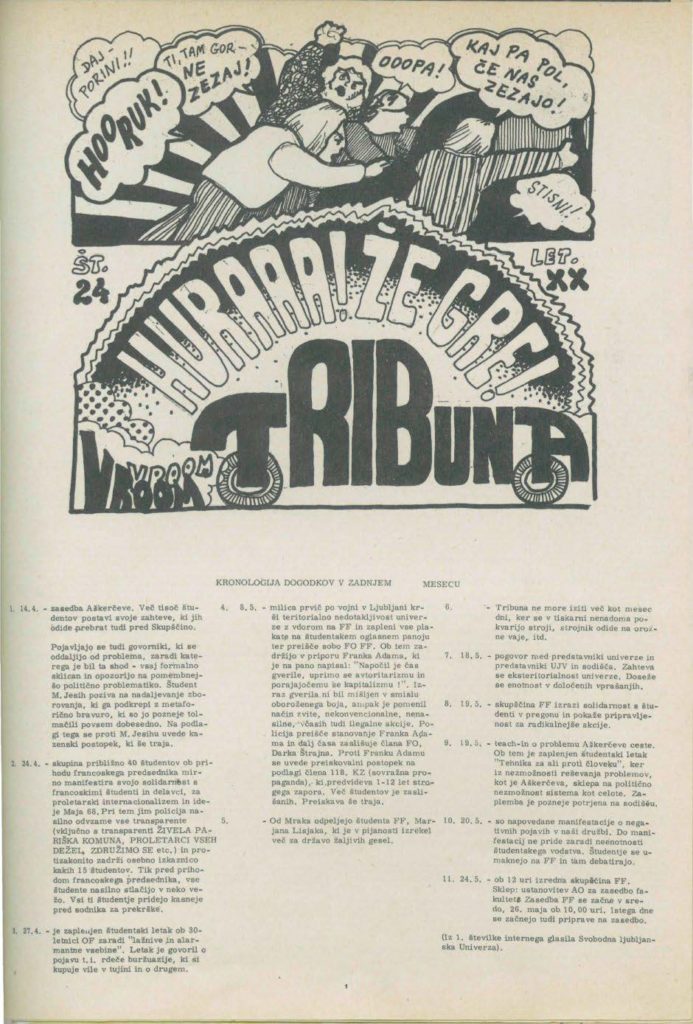
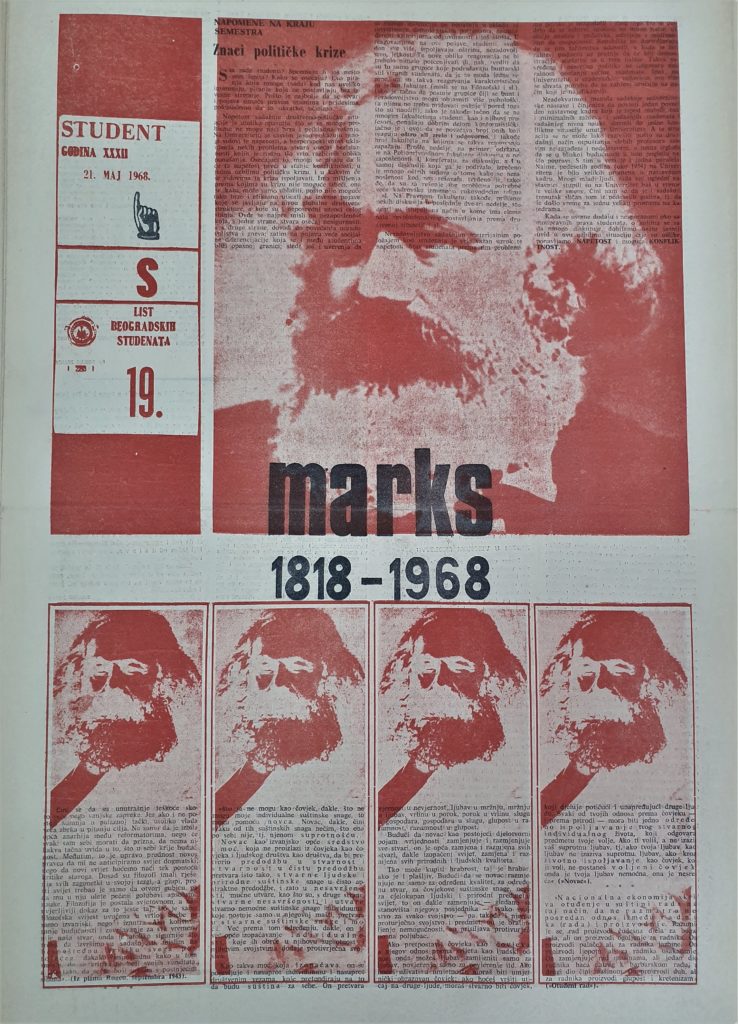
B) With Yugoslavia and particularly Slovenia in the centre of our project, critical studies of Yugoslavia represent the second, intermediate level of the state of the art. Such studies have been undertaken by Klasić, Jakovljević, Djurić and Šuvaković, Kanzleiter and Stojaković, and others. Klasić’s book Jugoslavija i svijet 1968 (Ljevak 2012) shows that Yugoslav student movement was specific to the unique geopolitical and economic position of non-aligned and self-managed Yugoslavia, while also being integrated into the global movement via its forms (e.g., student occupation, sit-ins, alternative universities) and demands (e.g., social equality). Another single-authored book on Yugoslav 1968 is Jakovljević’s Alienation Effects (U of Michigan P 2016). Jakovljević links Yugoslav performance art to the country’s self-management. This attempt at democratization of both art and economy resulted in a culture difficult to classify. From this perspective, the student protests of 1968 are just one early case of this culture, according to Jakovljević. When it comes to edited volumes, Djurić and Šuvaković’s Impossible Histories (MIT P 2003) is the first influential survey of Yugoslav artistic experiments from the avant-garde to the neo-avant-garde. The combination of Austro-Hungarian, French, German, Italian, and Turkish influences gave Yugoslav avant-garde a distinct character unlike those of other East-Central European avant-gardes, the contributors argue; and the unique trajectory of postwar Yugoslavia distinguished Yugoslav neo-avant-garde as well. Finally, Kanzleiter and Stojaković’s 1968 in Jugoslawien (Dietz 2008), an edited volume published at the 40th anniversary of May ’68, addresses the Yugoslav case as a major lacuna in international studies of May ’68. The irreducibility of this case, where the ruling party was the only ruling power globally to perceive the demonstrations as a continuation of its own politics, is approached in the volume from the perspective of Yugoslav economic self-management and geopolitical non-alignment.
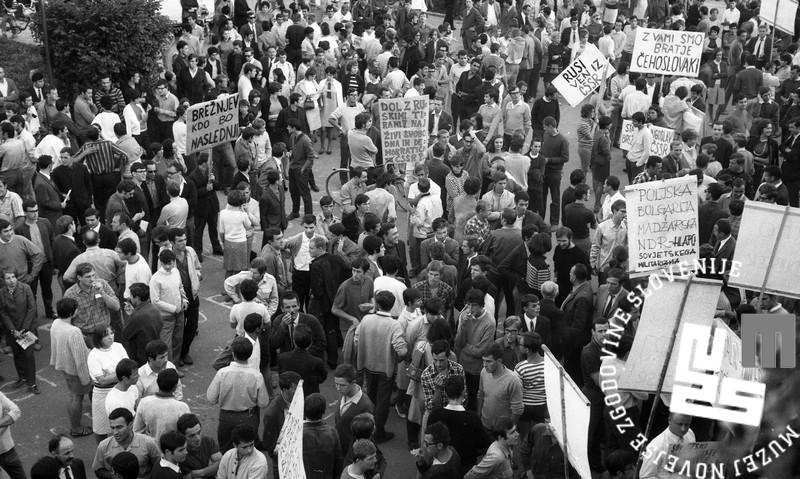
7 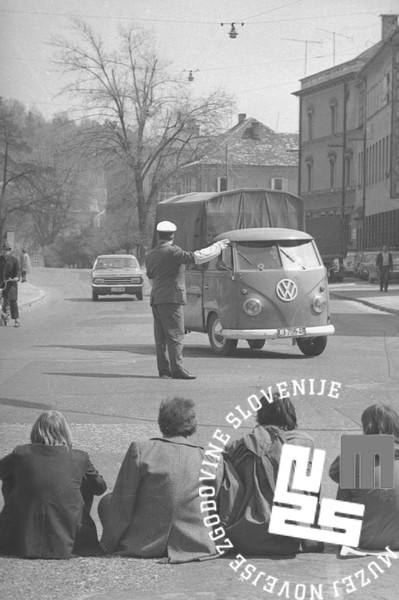
8 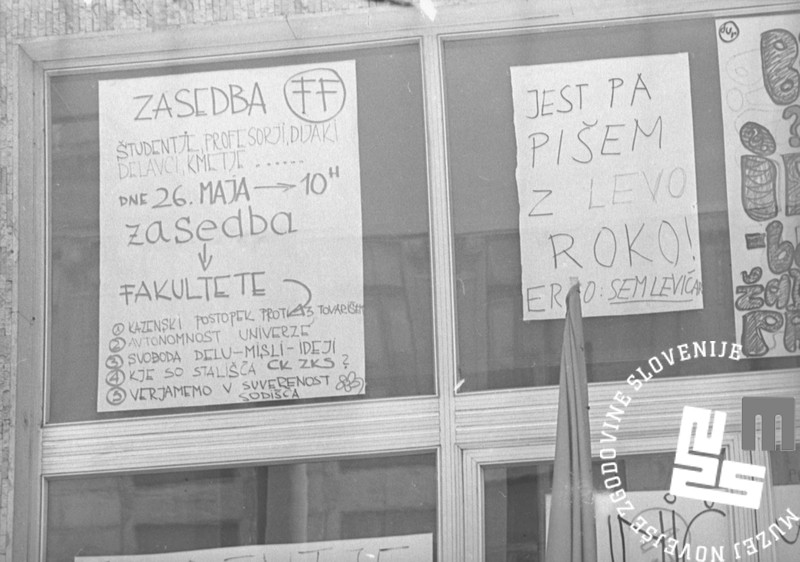
9 
10
Picture 7: Students protesting against the Soviet occupation of Czechoslovakia, Ljubljana, 1968 (fragment; photo: Svetozar Busić, source: Muzej novejše zgodovine Slovenije)
Picture 8: Students protesting against the traffic noise in Aškerčeva street, Ljubljana, April 1971 (fragment; photo: Edi Šelhaus, source: Muzej novejše zgodovine Slovenije)
Pictures 9, 10: Student protests – the occupation of the Faculty of arts, Ljubljana, Maj 1971 (photo: Edi Šelhaus, source: Muzej novejše zgodovine Slovenije)
This project will broaden Klasić’s focus on Belgrade to include its relation to Ljubljana and Zagreb. It will also expand Jakovljević’s framework, adding literature to performance art, and geopolitical non-alignment to economic self-management. Additionally, our project will return to the topic of Impossible Histories by adding the perspectives of world-systems and world-economy. Finally, the project will deepen the approach set forth in 1968 in Jugoslawien by zooming in on Slovenia and by adding the level of Yugoslav artistic practices.
C) Finally, although Slovenian literary history has not yet posed the question of how modernist literature, neo-avant-garde literary texts, critical theory, and the literary media both shaped and were shaped by the Yugoslav student movement of 1968–72, there are also a few book-length studies on Slovenian May ’68 that the project can work with. In 1982, a group of sociologists who had participated in the student movement published Študentsko gibanje 1968–72 (ZSMS 1982), a richly prefaced and annotated selection of texts published between 1968–72 in Slovenian student magazines and other outlets; this remains the most useful document of the Slovenian student movement to date, from its unionist phase, to its radicalization in the direction of global politics, to a final split with the literary and artistic part of the membership. This volume and the period it covers is also the main focus of Mihevc’s Ključ je v naših rokah! (Univerza 2008), a recent book on the impact of student protests on university politics in modern Europe. Finally, Ramšak’s 2013 dissertation Oporečništvo v samoupravnem socializmu was published as a book in 2018. Ramšak’s focus on Slovenian dissidents in socialist Yugoslavia leads him to a thorough discussion of the 1968–72 student movement in Slovenia and the rest of Yugoslavia.
Our project will build on Študentsko gibanje 1968–72 to locate and analyze the main literary and artistic manifestations of the movement, which are especially characteristic of the second, most radical and internationalist phase. In this way, the project will also supplement Mihevc’s book, which lacks a cultural dimension. Finally, this will enable the project to contribute to the topic of Slovenian dissidents, where Ramšak’s recent book calls for a discussion of literature and theatre as mediums of Yugoslav dissidents. On this basis, our project will study Slovenian literary modernism within the transformative historical conjuncture of 1968 and in the world-system perspective; it will analyze the political events, the counterculture, literature, and theory in Slovenia as so many (semi)peripheral developments at the intersection of the literary and economic world-systems.
A Detailed Description of the Work Programme
During the last fifty years, May ’68 as the most significant global antisystemic movement has predominantly been portrayed as a revolt led by students and workers around the world against state-led industrial society typical both for the US hegemony and for the Soviet alternative. As such, the revolution tends to be associated, on one side, with NATO member states such as France, and, on the other, with members of the Warsaw Pact such as Czechoslovakia. However, May ’68 also had massive resonance in Yugoslavia, a country that not only was aligned neither to NATO nor to the Soviet bloc but was even the leader of the Non-Aligned Movement, a worldwide attempt to oppose both geopolitical blocs. Yugoslavia (and Slovenia as its constitutive part) is thus a rare case of May ’68 going beyond the critique of the Cold-War stalemate; a case where this critique of both the US and the USSR was always already the official position of the regime itself; a case where Fordist industrial society common both to the capitalist West and the real-socialist East was challenged by the experiment of workers’ self-management, which Yugoslavia introduced two decades before 1968 and abolished two decades after it. What was, then, the object of critique in and following 1968 in a country like Yugoslavia?
The research project described here will address this question starting from the hypothesis that in Slovenia, apparently the most “westernized” republic of socialist Yugoslavia, more than in many other countries, critique voiced or inspired by May ’68 was displaced from the field of politics to that of culture and literature. Specifically, as the anti-imperialist concerns of the ’68 movement were largely shared by official Yugoslav foreign policies, the protesters in Yugoslavia focused less on the Cold War than on Yugoslavia itself, and within it less on critical economic analysis than on the more general cultural issues of social inequality (within and outside the university), inequality resulting from the Communist Party’s reformist efforts to combine socialist self-management with the principles of Western market economy. In France or, say, the US, the counterculture that accompanied the general strikes and the student revolts of 1968 was a highly visible yet quickly commodifiable dimension of the revolt (as noted, say, by world-systems analysts and Ross, May ’68 and Its Afterlives); at the same time, this counterculture, where student protests were more vocal than workers’ strikes, was arguably at the centre of revolt in Yugoslavia (see Klasić, Jugoslavija i svijet 1968). Hence also a relatively important role of modernist literature, counterculture, neo-avant-garde groups, and manifestos as well as philosophy and critical theory, all key cultural mediums of the era. The international student movement has helped introduce Yugoslav society to the radical modernist practices of Paris and other metropoles of the literary world-system, where critique of bourgeois politics and economy but also of aesthetics, literature, and sexuality brought together literary innovations from early 20th-century modernisms and the critical theoretical discourse that just emerged at the time out of a deconstructed continental philosophy.
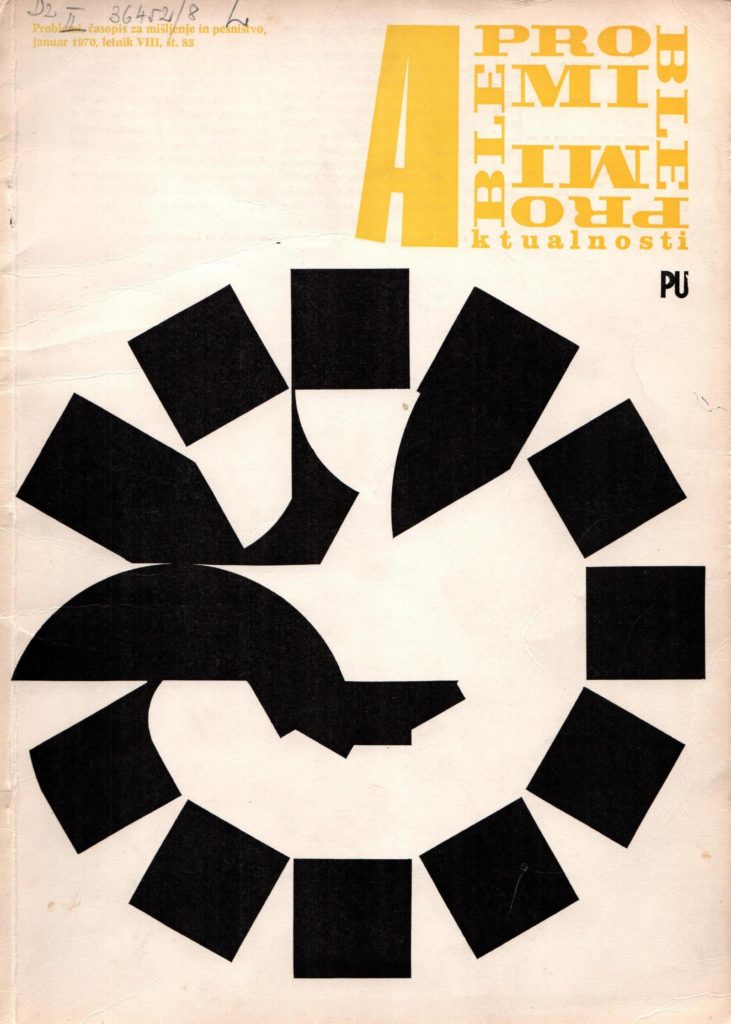
11 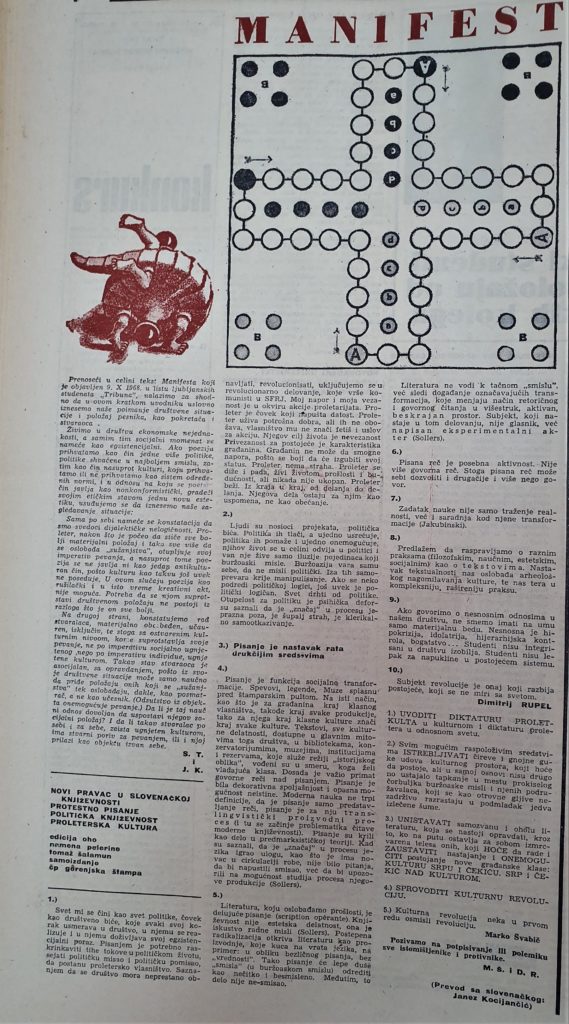
12 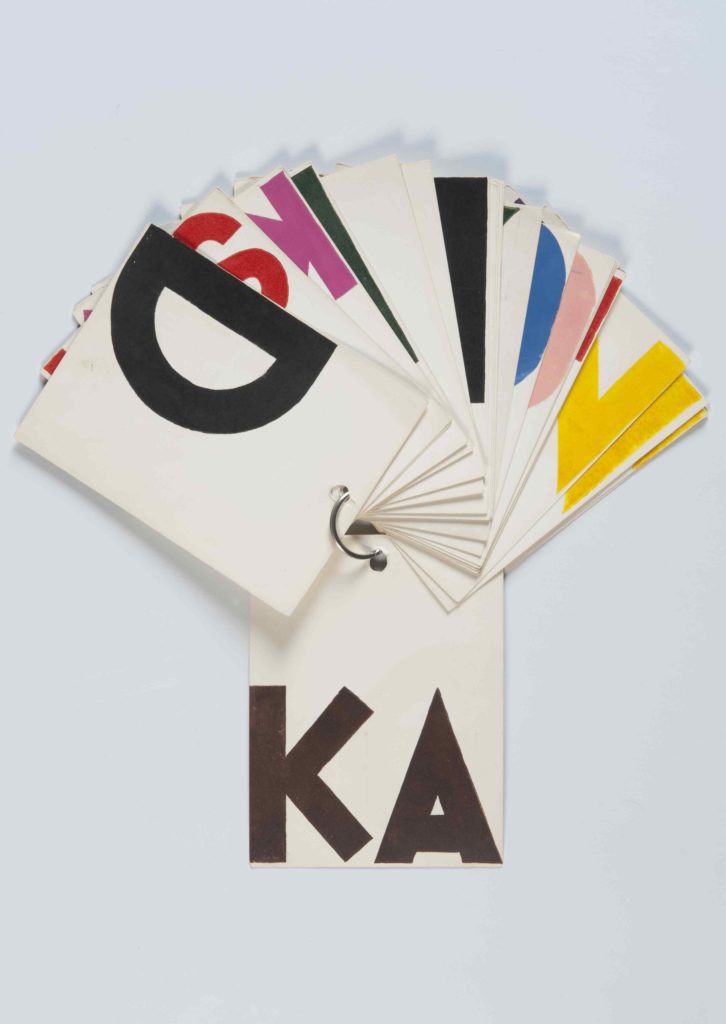
13
Picture 11: Problemi 1970 – Programmed Art
Picture 12: A page from the Novi Sad student magazine Index (18 October 1968): translation of Slovenian neo-avant-garde manifestos
Picture 13: Object OHO – 2 poems (1966; source: Moderna galerija, Ljubljana)
Some of the most world-renowned oeuvres produced by citizens of Yugoslavia (Abramović’s performance art, the OHO group’s conceptual art, Black Wave film, Šalamun’s poetry, Žižek’s critical theory) go back to the 1960s. Together with aesthetic currents from other locales of the semi-periphery of the world-system (notably the Latin American Boom), these and similar phenomena arguably gave a second life to the hitherto Europe-based modernism, which by the sixties was limited to such forms as nouveau roman (see Anderson, “Modernity and Revolution”). This final season of European modernism was followed in the core of the system by post-modernism in aesthetics and neo-conservatism in politics, with many protagonists of May ’68 becoming “new philosophers” critical of socialism and revolution in the name of liberalism and human rights. As for Slovenia and other Yugoslav republics, the final season of European modernism was followed by a party-led suspense of liberal reforms, a crisis of the economic, political, and cultural experiment that was self-management, a dissolution of the state more violent than in any other socialist country, and the emergence of independent successor states. In these new states, which by now are either in or on their path to the EU, modernism has been immunized by being accepted into the state institutions of art. This outcome of the final season of modernism offers a backdrop against which the radical modernism of the sixties reveals itself as having been deeply integrated, via the student movement around the world, into the structures of everyday life, but in a way that made it function within these structures as a utopian alternative.
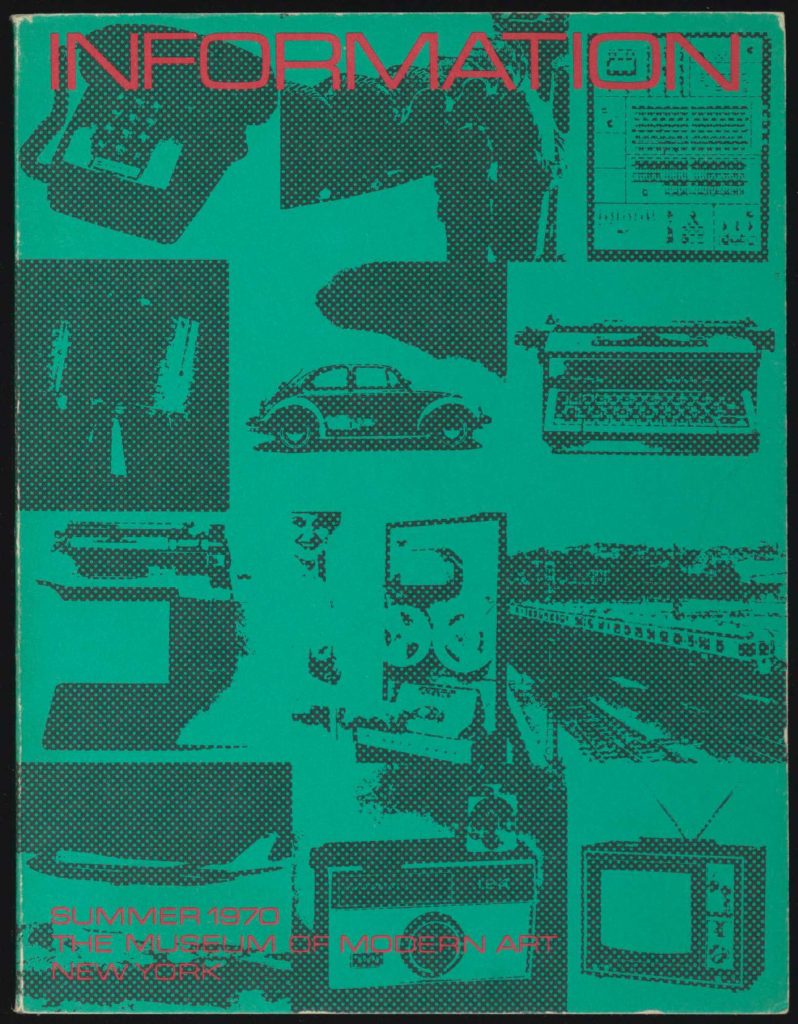
14 
15
Picture 14: Covers of the exhibition catalogue Information (Museum of Modern Art, New York, Summer 1970), which includes the Slovenian group OHO
Picture 15: Milenko Matanović: Intercontinental project America – Europe (from the catalogue Information; source: Moderna Galerija v Ljubljani)
The events metonymically termed May ’68 resonated both in the venerated halls of Sorbonne, where students displayed their red and black flags, and on the peaks of the Himalaya, where the foremost climber of the period ceased to display the national flag after learning about the events. Protesters included both anonymous industrial workers in Southern France and already (in)famous student leaders in Paris; the movement engulfed both students in Mexico and workers in Italy, and students both of Columbia University and of South Carolina State University. However, the events were also met with disapproval both by liberal and by socialist regimes; they were rejected both by such incorrigible humanists as Adorno and by such provocative anti-humanists as Lacan. Given this enormous scope of the events, it is all the more remarkable that such central parts of the field of culture as literature and critical theory have so far been relatively neglected in scholarly accounts of May ’68, as these have mainly limited their focus on politics and economy.
These are hence the two main problems that appear once we approach May ’68 from the perspective of Yugoslavia. First, if May ’68 was above all a worldwide critique of both the Western hegemony and the Eastern alternative, why was its impact so strong even in a country rejecting both geopolitical blocs? Second, if May ’68 impacted all the social spheres all around the world, why do its literary, philosophical, and overall cultural dimensions come to the fore only once we focus on a country like Slovenia, a republic of a non-aligned socialist Yugoslav federation?
In terms of the aims of the described project, the following sets of Slovenian texts and contexts from 1965 to 1975 will be investigated, each compared with developments in Paris as the core of the literary world-system as well as with those in Yugoslavia as an in-between periphery (Belgrade, Zagreb, etc.):
A. Literature
- Texts: student bulletins, periodicals (Tribuna, Problemi, etc.), manifestos, avant-garde collective volumes (Pericarežeracirep, Katalog, Edicije OHO, etc.), book series (“Znamenja” etc.), self-published books and books published by state publishers, literature aired on the Ljubljana student radio (RŠ);
- the reception and re-writing of metropolitan modernist forms and topics in Slovenia (dadaism and surrealism, nouveau roman, situationism, Tel Quel, concrete poetry, lettrism, land art, etc.).
- The focus: the literary and transliterary production of neo-avant-garde groups (OHO, Katalog, Nomenklatura, etc.) and individual writers (Kermauner, Šalamun, Hanžek, Geister, Svetina, Švabić, Jovanovič, Rupel, Zlobec, Filipčič, Zagoričnik, Chubby, Dekleva, Detela, Gajšek, et al.) in comparison with French (post)structuralism, situationism, Tel Quel, and nouveau noveau roman.
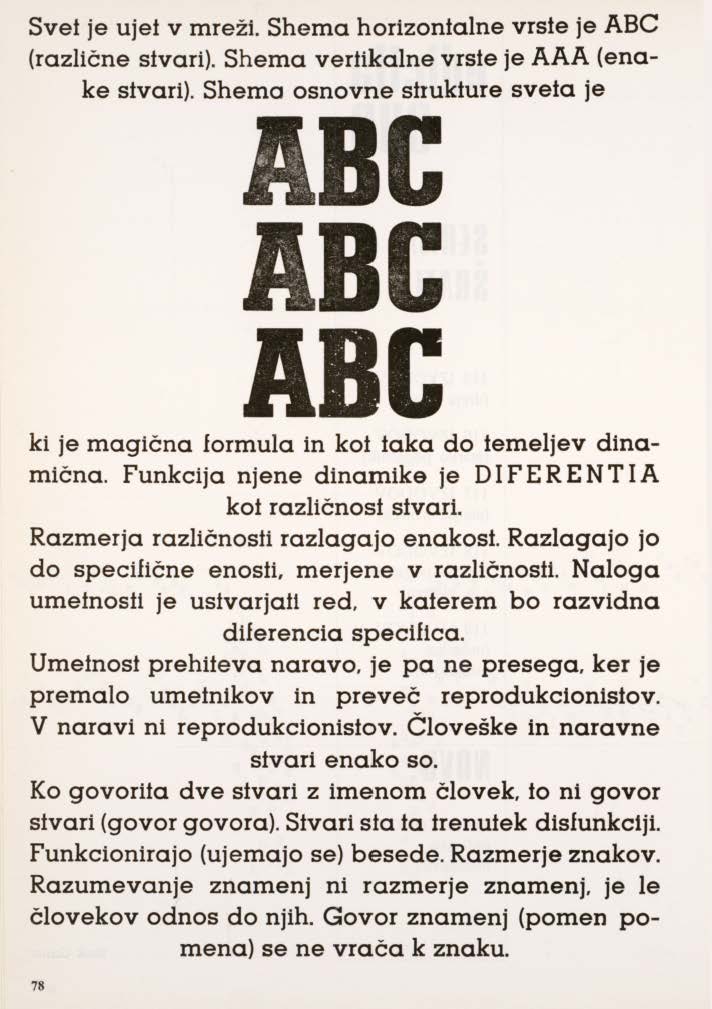
16 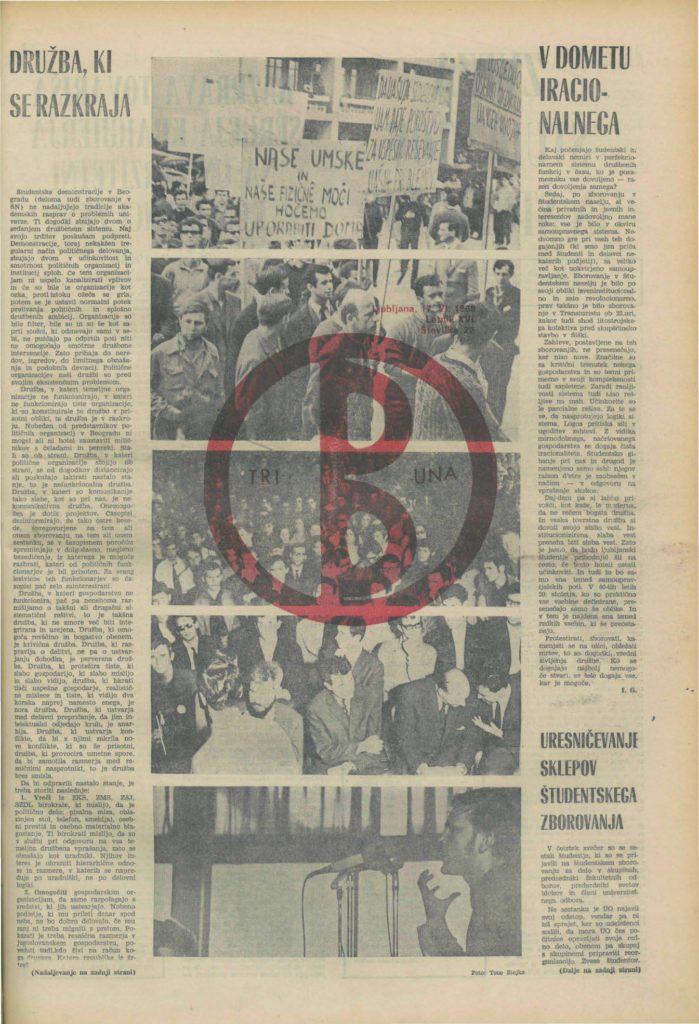
17 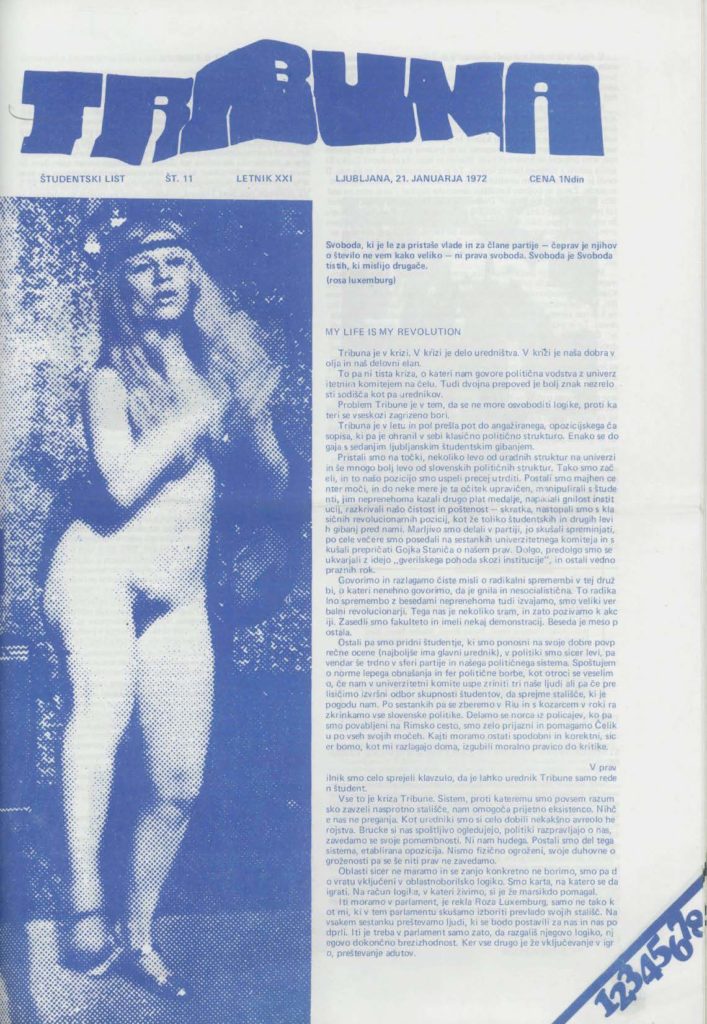
18
Picture 16: Iztok Geister (group OHO), a theory-literature hybrid, Problemi – Katalog, 1968
Picture 17: Cover page of the student magazine Tribuna (17 June 1968)
Picture 18: Cover page of the student magazine Tribuna (21 January 1972)
B. Critical theory
- Texts: periodicals (Problemi, Tribuna, etc.), bulletins, book series, and individual books;
- references to and the reception and influence of: Marxism (from Marx to Mao); Djilas and the Yugoslav “Praxis” school; prominent leaders and intellectuals of the worldwide student movement (Rubin, Dutschke, Cohn-Bendit, Sartre, Marcuse, etc.); French structuralism, Lacanian psychoanalysis, Althusserian historical materialism, early post-structuralism; Frankfurt school; Italian workerism and autonomism.
- The focus: peripheral Ljubljana as the place of origin of theories that, developing matrices adopted from the French theory, quickly gained international acclaim (the Ljubljana school of Lacanian psychoanalysis: Žižek, Dolar, Salecl, Močnik, Rotar, Skušek, et al.).
C. Culture and counterculture
- Student culture, hippies, alternative university, teach-ins; rock and consumer culture; Fordist workers’ culture; East European proto-dissidence.
- The focus: study stays of Slovenian intellectuals and writers in Paris and the US as a gateway to modernization and westernization (between leftist radicalism and classical liberalism).
D. Reflections and memories of May ’68 in literature and theory
- Narrativization of the events in fiction and drama between experience and memory, and between mythology and distancing (Rupel’s Tajnik šeste internacionale, Švabić’s Šund roman, Jovanovič’s Igrajte tumor v glavi, Dolenc’s Vampir z Gorjancev, Dekleva’s Oko v zraku and Pimlico, etc.);
- the tradition of May ’68 in the theory of the civil society movements of the 1980s (radical left, human rights activists, feminists, LGBT, ecologists, etc.).
- The focus: what has become of May ’68 and ist transformative drive in the period of postmodernism, postcommunism, and neoliberalism?
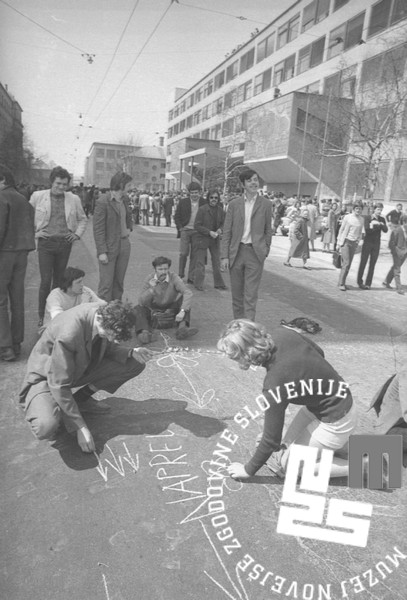
The project team will study the various kinds of relevant text listed above by employing qualitative methods (critical textual interpretation and close reading) as well as quantitative analysis of data obtained from the text corpus. To this end, the project will produce and, applying the most advanced approaches in digital humanities, analyze the archive of Slovenian literary and theoretical production of the period 1965–1975. First, the existing full-length digital copies of the student periodicals that are publicly accessible in the Digital Library of Slovenia (dLib) will be examined to provide a selection of relevant texts. These are texts related to the events of 1968–72 thematically, referentially, or by the contexts of their publication or production. The selection will be bibliographically registered, split in separate searchable texts, provided with basic metadata and analytical descriptions and stored in a digital repository. An application based on XML technology will generate the web publication of the relevant texts as well as enable their dynamic presentation and analysis according to particular categories (genre, author, gender, generation, date, etc.). Additionally, other relevant publications not yet included in dLib (such as student bulletins) will be scanned and transformed into a searchable format. Composing a digital archive will not be an end in itself, but will rather serve as a prerequisite for quantitative and qualitative corpus analysis. This analysis will be focused on the question of transformations in four distinct yet closely interconnected social spheres:
- the national and literary language: starting from the hypothesis that the 1960s mark a significant linguistic change in modern literary cultures, the project team will identify symptoms of the decentralization of literary language (as it was based on the national literary canon); a key symptom seems to be the increase in the use of elements and structures borrowed outside the literary and the national, mainly from sociolects, slang, minoritarian languages, historical and dialectal varieties of Slovenian, and foreign languages (South Slavic languages, English, Italian, German); special emphasis will be placed on tracing the emergence of écriture feminine in the archived texts;
- the relationship between literature and visual arts: starting from the hypothesis that the 1960s mark the beginning of the predominance of visual media over the print, the project team will elucidate the share, semantics, and syntax of non-linguistic, iconic texts and visual-literary hybrids in print (“Kritik der Bleiwüste” [“critique of dense text”] and the raising prevalence of the visual in German publications of theory around 1968 was also noted in Felsch’s Der lange Sommer der Theorie [C.H. Beck 2015]);
- the generational structure of the public sphere: starting from the hypothesis that the conjuncture of 1968 marks the formation of students as a new political subject in the public sphere, the project team will assess the different age groups of authors that appear or are mentioned in the proposed archive of serial publications;
- the patriarchal structures of post-war society and women’s emancipation: as the 1968 revolt coincided with second-wave feminism and engendered several ensuing civil society movements, including feminism and LGBT, the project team will obtain quantitative data about the representation of women authors and feminist issues in the proposed corpus.
Methodologically, the project will be an interdisciplinary investigation combining the approaches and the findings of contemporary world-systems analysis with those of recent modernism studies and world literature studies, especially those approaches that refer to world-systems analysts and can hence be used to retool and refine the world-systems perspective according to the needs of literary research. In this way, the research on economic history conducted by Wallerstein, Arrighi, Hopkins, and other world-systems analysts will be used to draw out relevant analogies between the various centres of the ’68 revolt without having to rely on Cold-War oppositions. And the work on world literature done recently by Casanova (La République mondiale des Lettres, Seuil 1999), Moretti (Distant Reading, Verso 2013), Beecroft (An Ecology of World Literature, Verso 2015), and other literary historians who have been adapting world-systems analysis for literary studies will serve the proposed project in its endeavor to add to the world-systems perspective the kind of concretization that can be offered by world literature studies.
On this basis, the project will follow relevant strands of contemporary modernism studies and digital humanities in order to collect the literary material in question; polysystems theory and the theory of intertextuality, in order to structure the collected literary material; emerging critical studies of Yugoslavia, in order to zoom in on the literary and overall cultural scene in the 1960s and 1970s Yugoslavia; and, finally, the state of the art in individual philologies, notably Slovenian studies, in order to analyze and interpret selected literary and theoretical texts.
Project Management: Detailed Implementation Plan and Timetable
The work of the project team composed of researchers at different career stages will be organized on a daily basis and managed by the project leader using shared online platforms (e.g., Dropbox and Google Docs) as well as trimonthly work meetings.
The structure and scope of the project team, as well as its membership in the program team of the host institute, will enable sufficient flexibility, guaranteeing in unforeseeable events such as illness a successful realization of the project goals.
The work on the project will be organized according to the following timetable:
- Archival work in Slovenian libraries and archives as well as in the dLib e-library: collecting primary sources from 1965–75 that are associated with the Slovenian student movement of 1968–72 in terms of topic, production, and/or medium (books, journals, magazines, student bulletins, miscellanea); creating a bibliography of the relevant texts of the period. (Months 1–12.)
- Selection and digital enhancement of texts that are digitized and made searchable in the dLib library; additional digitization of relevant sources. (Months 6–12.)
- Work on a digital corpus of literary, transliterary, and theoretical texts associated with the Slovenian student movement (literary manifests and programs; literary and transliterary production of neo-avant-garde groups; modernist literary texts addressing the student movement at home or abroad or appearing in the movement’s publications; theoretical texts reflecting on the transformations of the literary and the social in the context of the student movement); work on a structured database extracted from the digital corpus. (Months 6–18.)
- Study of selected French theoretical, literary, and programmatic texts associated with the student movement in the period 1968–75. (Months 1–18.)
- Upgrading of the methodologies needed to interpret the selected texts and to quantitatively analyze the digital corpus. (Months 1–12.)
- International colloquium on modernism, transliterature, and critical theory at the 50th anniversary of May ’68, featuring four international and four Slovenian contributors; online publication of the papers. (October 2018.)
- Work on the proceedings of the October colloquium in the format of a special issue of an international peer-reviewed and indexed scholarly journal. (Months 6–12.)
- Quantitative and qualitative analysis of the digital corpus; work on and publication of at least three research articles in international peer-reviewed and indexed journals: a) on the selected Slovenian texts; b) on Slovenian and French literary and theoretical production associated with May ’68; c) on the findings of the analysis of the digital corpus. (Months 12–24.)
- Work on an exhibition of literary and theoretical works manifesting social, ideological, personal, memorial, or conceptual links between the revolutions of 1968 and 1989. (Months 6–16.)
- International conference on the legacy of May ’68 at the 30th anniversary of the revolution of 1989: some twenty international and Slovenian contributors (mainly literary and cultural historians, sociologists, art historians, and philosophers). (November 2019.)
- Launch of the exhibition of the literary and theoretical works that manifest links between the revolutions of 1968 and 1989; a co-located round table targeting Slovenian media as well as the audience of the exhibition. (November 2019.)
- Work on a freely accessible project website with the following features: a) a digitized corpus of texts; b) a structured database; c) results of corpus analysis; d) pre-published and/or published versions of the articles written by the project team; e) a bibliography; f) visual material. (Months 24–36.)
- Work on and publication of at least three research articles in international peer-reviewed and indexed journals. (Months 24–36.)
- Work on a research monograph on the topic of the project. (Months 12–36.)
With a digital corpus, a bibliography of the relevant texts of the years 1968–72, a research monograph, a special issue of an international journal, an exhibition, and a series of individual research articles as its main outputs, the project’s feasibility is guaranteed by the individual and institutional capacities of the project team. Project leader (PL) is a renowned scholar of Slovenian studies, comparative literature, and literary theory, who has published widely read English-language monographs on both the literature and the theory of the period in question, as well as numerous peer-reviewed journal articles employing and assessing the methods proposed for this project, especially world literature studies, world-systems analysis, and the theory of intertextuality. Institutionally, PL is able to use the resources of the Institute of Slovenian Literature in Ljubljana, which he heads, and the Faculty of Arts in Ljubljana, where he teaches, as well as the international network that he can use as a member of Academia Europaea and ESCL/SELC and as an editorial-board member of arcadia, CLCWeb, and Primerjalna književnost. These will be further augmented by the other members of PL’s inter-disciplinary and inter-institutional project team.
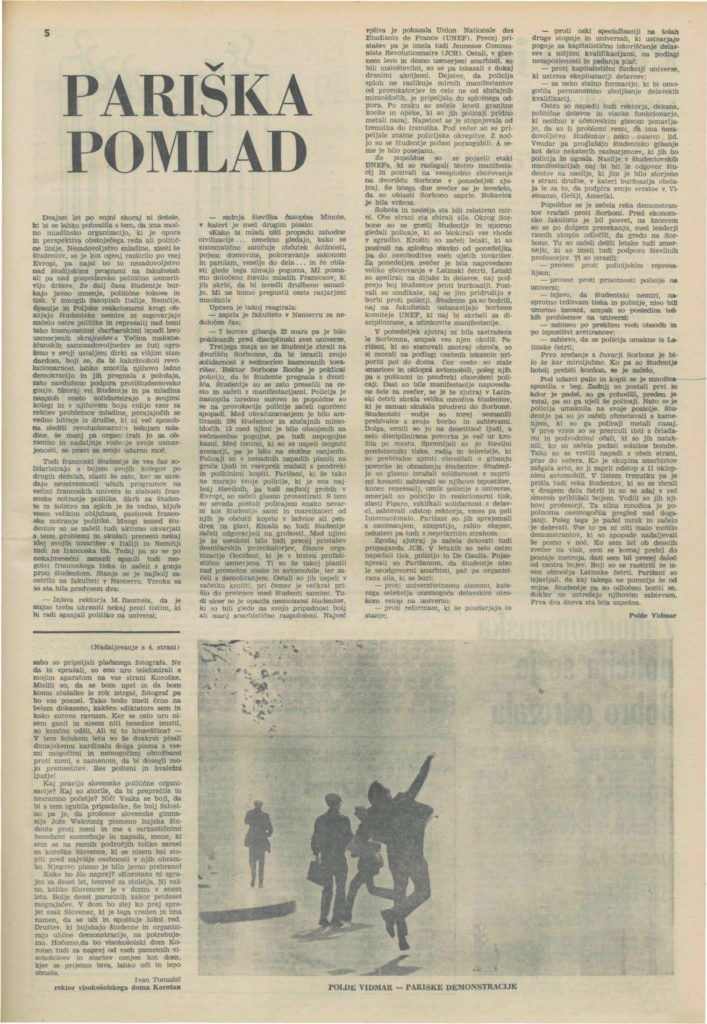
Bibliography
Anderson, Perry. “Modernity and Revolution.” New Left Review I/144 (1984): 96–113.
Arrighi, Giovanni; Terence Hopkins; Immanuel Wallerstein. “1968: The Great Rehearsal.” Antisystemic Movements. London: Verso, 1989. 97–118.
———. “1989, the Continuation of 1968.” Review 15.2 (1992): 221–42.
Bahun, Sanja. “The Balkans Uncovered: Toward Histoire Croisée of Modernism.” The Oxford Handbook of Global Modernisms. Eds. Mark Wollaeger; Matt Eatough. Oxford: Oxford UP, 2012. 25–47.
Baškovič, Ciril; Pavle Gantar; Marjan Pungartnik; Pavle Zgaga. Študentsko gibanje 1968–72. Ljubljana: Republiška konferenca ZSMS, 1982.
Beecroft, Alexander. An Ecology of World Literature. London: Verso, 2015.
Beogradski univerzitet i 68. Zbornik dokumenata o studentskim demonstracijama. Beograd: CMU, 1989.
Berglieb, Klaus. 1968: Literatur in der antiautorären Bewegung. Frankfurt: Suhrkamp, 1993.
Bourdieu, Pierre. Homo Academicus. Paris: Minuit, 1992.
Brinton, Maurice. Paris: May 1968. London: Solidarity, 1969.
Casanova, Pascale. La République mondiale des Lettres. Paris: Seuil, 1999.
Caute, David. The Year of the Barricades: A Journey Through 1968. New York: Harper & Row, 1988.
Čepič, Zdenko. »Burno leto 1968. Politična sprostitev. Zaton partijskega liberalizma.« Slovenska novejša zgodovina. 2. Eds. Jasna Fischer et al. Ljubljana: Mladinska knjiga, 2005. 1054–66, 1069–75.
Combes, Patrick. Mai 68, les écrivains, la littérature. Paris: L’Harmattan 2008.
Djurić, Dubravka; Miško Šuvaković, eds. Impossible Histories: Historical Avant-Gardes, Neo-Avant-Gardes, and Post-Avant-Gardes in Yugoslavia, 1918–1991. Cambridge (MA): MIT P, 2003.
Doyle, Laura; Laura Winkiel, eds. Geomodernisms: Race, Modernism, Modernity. Bloomington: Indiana UP, 2005.
Drake, David. Intellectuals and Politics in Post-War France. Houndmills: Palgrave Macmillan, 2002.
Dreyfus-Armand, Geneviève; et al. Les années 68. Bruxelles: Complexe, 2000.
Dutschke, Rudi. Mein langer Marsch. Hamburg: Rowohlt, 1980.
Elbaum, Max. Revolution in the Air: Sixties Radicals Turn to Lenin, Mao and Che. London: Verso, 2002.
Felsch, Philipp. Der lange Sommer der Theorie: Geschichte einer Revolte 1960–1990. Munich: C.H. Beck, 2015.
Ferry, Luc; Alain Renaut. French Philosophy of the Sixties. Trans. Mary H. S. Cattani. Amherst: U of Massachusetts P, 1990.
Fichter, Madigan. “Yugoslav Protest: Student Rebellion in Belgrade, Zagreb and Sarajevo 1968.” Slavic Review 75 (2016): 99–121.
Fink, Carole; Philipp Gassert; Detlef Junker, eds. 1968: The World Transformed. Cambridge: Cambridge UP, 1998.
Friedman, Susan Stanford. Planetary Modernisms. New York: Columbia UP, 2015.
Gabrič, Aleš. »Intelektualci kot opozicija. Približevanje kulturnih dobrin širšemu krogu ljudi. Obračun s kulturniško opozicijo. Sproščena šestdeseta leta v kulturi. Intelektualci v primežu ‘svinčenih let’. Med modernizmom in postmodernizmom. Popularna kultura.« Slovenska novejša zgodovina. 2. Eds. Jasna Fischer et al. Ljubljana: Mladinska knjiga, 2005. 1024–35, 1056–69, 1125–27, 1139–43.
Habjan, Jernej. “From Cultural Third-Worldism to the Literary World-System.” CLCWeb 15.5 (2013). Web.
Hoyles, Andre. “General Strike: France 1968.” Trade Union Register 1969. Web.
Jakovljević, Branislav. Alienation Effects: Performance and Self-Management in Yugoslavia, 1945–91. Ann Arbor: U of Michigan P, 2016.
Jameson, Fredric. A Singular Modernity. London: Verso, 2002.
Juvan, Marko. History and Poetics of Intertextuality. West Lafayette: Purdue UP, 2008.
———. Prešernovska struktura in svetovni literarni sistem. Ljubljana: LUD Literatura, 2012.
———. “Worlding Literatures between Dialogue and Hegemony.” CLCWeb 15.5 (2013). Web.
Kanzleiter, Boris. “1968 in Yugoslavia.” Between Prague Spring and French May. Eds. Martin Klimke; Jacco Pekelder; Joachim Scharloth. New York: Berghahn Books, 2011. 84–100.
———; Krunoslav Stojaković, eds. 1968 in Jugoslawien. Bonn: Dietz, 2008.
Katsiaficas, George N. The Imagination of the New Left: A Global Analysis of 1968. Cambridge (MA): South End P, 1987.
Klasić, Hrvoje. Jugoslavija i svijet 1968. Zagreb: Ljevak, 2012.
Koron, Alenka. “The Impact of European Structuralism on Slovenian Literary Criticism, 1960–2000.” Slovene studies 36.1 (2014): 3–17.
Kurlansky, Mark. 1968: The Year that Shook the World. New York: Random House, 1998.
Lesjak, Jure. »O transformaciji in radikalizaciji študentskih gibanj«. ČKZ 39.244 (2011): 121–27.
Mihevc, Bogomir. Ključ je v naših rokah! Študentska gibanja za univerzo in boljši študij. Ljubljana: Univerza v Ljubljani, 2008.
Miller, Mark. “Yugoslavia’s 1968.”. Promises of 1968. Ed. Vladimir Tismaneanu. Budapest: CEU P, 2011. 227–40.
Moretti, Franco. Distant Reading. London: Verso, 2013.
———. Signs Taken for Wonders: On the Sociology of Literary Forms. Second Edition. London: Verso, 2005.
Neubauer, John; Marcel Cornis-Pope. “1956/1968: Revolt, Suppression, and Liberalization in Post-Stalinist East-Central Europe.” History of the Literary Cultures of East-Central Europe. 1. Eds. Marcel Cornis-Pope; John Neubauer. Amsterdam; Philadelphia: John Benjamins, 2004. 82–105.
Poniž, Denis. »Šestdeseta leta. Poetika lingvizma in novega (jezikovnega) simbolizma. Sedemdeseta in osemdeseta leta. Oblika kot središčni pesniški problem. Pesniški let generacije, rojene v začetku šestdesetih let.« Jože Pogačnik et al., Slovenska književnost III. Ljubljana: DZS, 2001. 103–13, 116–40.
Popov, Nebojša. Društveni sukobi izazov sociologiji. »Beogradski jun« 1968. Beograd: Glasnik, 2008.
Ramalho Santos, Irene; António Sousa Ribeiro, eds. Translocal Modernisms: International Perspectives. Bern: Peter Lang, 2008.
Ramšak, Jure. Oporečništvo v samoupravnem socializmu: vsebina in položaj družbene kritike v Sloveniji, 1972–1980 : doktorska disertacija. Koper : [J. Ramšak], 2013.
Ross, Kristin. May ’68 and Its Afterlives. Chicago: U of Chicago P, 2002.
Rubin, Jerry. Do It. Scenarios of the Revolution. New York: Simon and Schuster, 1970.
Sartre, Jean-Paul. Situations, VIII: Autour de 68. Paris: Gallimard, 1972.
Starr, Peter. Logics of Failed Revolt: French Theory after May ’68. Stanford: Stanford UP, 1995.
Štrajn, Darko.»Kako razumeti študentska gibanja?« Zgodovina v šoli 17.3–4 (2008): 1–7.
Šuvaković, Miško. Anatomija angelov: razprave o umetnosti in teoriji v Sloveniji po letu 1960. Trans. Vlasta Vičič. Ljubljana: Sophia, 2001.
Troha, Gašper. Ujetniki svobode: slovenska dramatika in družba med letoma 1943–1990. Maribor: Aristej; Ljubljana: AGRFT, 2015.
Wallerstein, Immanuel. “1968, Revolution in the World-System.” Geopolitics and Geoculture: Essays on the Changing World-System. Cambridge: Cambridge UP, 1991. 65–83.
Wollaeger, Mark; Matt Eatough, eds. The Oxford Handbook of Global Modernisms. Oxford: Oxford UP, 2012.
